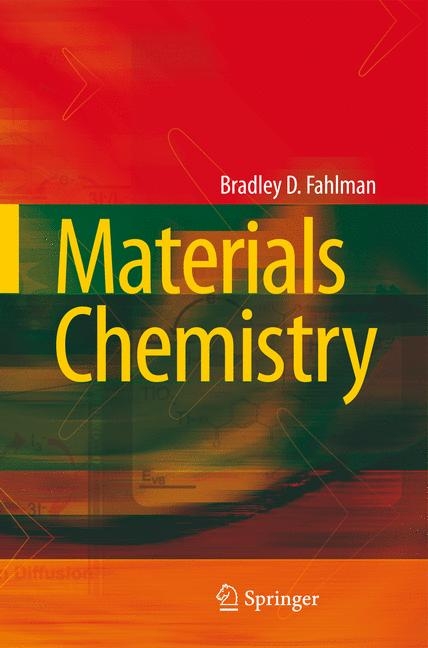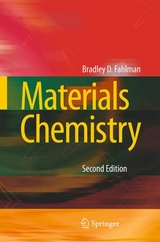Materials Chemistry
Springer-Verlag New York Inc.
978-1-4020-6119-6 (ISBN)
- Titel erscheint in neuer Auflage
- Artikel merken
Winner of a 2008 Textbook Excellence Award from the Text and Academic Authors Association (TAA)! Written to fill the need for a textbook that addresses inorganic-, organic-, and nano-based materials from a structure vs. property treatment, Materials Chemistry aims to provide a suitable breadth and depth coverage of the rapidly evolving materials field -- in a concise format. This modern treatment offers innovative coverage and practical perspective throughout, e.g.: the opening solid-state chemistry chapter uses color illustrations of crystalline unit cells and digital photos of models to clarify their structures, plus an ample amorphous-solids section; the metals chapter treats the full spectrum of powder metallurgical methods, complex phase behaviors of the Fe-C system and steels, and topics such as corrosion and shape-memory properties; the semiconductor chapter addresses evolution and limitations/solutions of modern transistors, as well as IC fabrication and photovoltaics; the polymer and 'soft' materials chapter describes all polymeric classes including dendritic polymers, as well as important additives such as plasticizers and flame-retardants, and emerging applications such as molecular magnets and self-repairing polymers; final chapters on nanomaterials and materials-characterization techniques are also carefully surveyed, focusing on nomenclature, synthetic techniques, and applications taken from the latest scientific literature.
Most appropriate for Junior/Senior undergraduate students, as well as first-year graduate students in chemistry, physics, or engineering fields, Materials Chemistry may also serve as a valuable reference to industrial researchers. Each chapter concludes with a section that describes important materials applications, while appendices include laboratory modules for materials synthesis and a comprehensive timeline of major materials developments.
Chapter 1 What is Materials Chemistry? Historical Perspectives; Considerations in the Design of New Materials; Design of New Materials Through a "Critical Thinking" Approach; References and Notes; Topics for Further Discussion; Further Reading . Chapter 2 Solid-State Chemistry Amorphous vs. Crystalline Solids; Types of Bonding in Solids; Ionic Solids; Metallic Solids; Molecular Solids; Covalent Network Solids; The Crystalline State; Crystal Growth Techniques; The Unit Cell; Crystal Lattices; Definitions and Nomenclature; Interstitial Crystal Lattices; Metal Oxide Lattices; Crystal Imperfections; Phase-Transformation Diagrams; Crystal Symmetry and Space Groups; Physical Properties of Crystals; Hardness; Cleavage and Fracturing; Color; Properties Resulting from Crystal Anisotropy; The Amorphous State; Sol-Gel Processing; Glasses; Cementitious Materials; Important Materials Applications I: Fuel Cells; References and Notes; Topics for Further Discussion; Further Reading. Chapter 3 Metals Mining and Processing of Metals; Powder Metallurgy; Metallic Structures and Properties; Phase Behavior of Iron and Iron-Carbon Alloys; Hardening Mechanisms of Steels; Stainless Steels; Non-Ferrous Metals and Alloys; The Coinage Metals; Aluminum Alloys; Refractory Metals; Shape-Memory Alloys; Metal Surface Treatments for Corrosion Resistance; Magnetism in Metals, Alloys, and Organometallic Complexes; Reversible Hydrogen Storage; Important (and Controversial!) Materials Applications II: Depleted Uranium; References and Notes; Topics for Further Discussion; Further Reading. Chapter 4 Semiconducting Materials Properties and Types of Semiconductors; Silicon-Based Applications; Silicon Wafer Production; Integrated Circuits; Field-Effect Transistors: Structure and Properties; Integrated Circuit Fabrication; Thin-Film Deposition Methodologies; Light-Emitting Diodes: There is Life Outside of Silicon!; Thermoelectric (TE) Materials; Important Materials Applications III: Photovoltaic (Solar) Cells; References and Notes;Topics for Further Discussion; Further Reading . Chapter 5 Organic "Soft" Materials Polymer Classifications and Nomenclature; Polymerization Mechanisms; Addition Polymerization; Heterogeneous Catalysis; Homogeneous Living Catalysis; Step-Growth Polymerization; "Soft Materials" Applications: Structure vs. Properties; Molecular Magnets; Polymer Additives: Plasticizers and Flame Retardants; Important Materials Applications IV: Self-Healing Polymers; References and Notes; Topics for Further Discussion; Further Reading. Chapter 6 Nanomaterials What is "Nanotechnology"?; Nanoscale Building Blocks and Applications; Zero-Dimensional Nanomaterials; Mechanism for the Nucleation/Growth/Agglomeration of Metal Nanoclusters; The First 0-D Nanoarchitecture: The Fullerenes; The Solution-Phase Synthesis of Nanoparticles; Self-Assembly of Nanoparticles/Nanoclusters into Arrays; One-Dimensional Nanostructures; Carbon Nanotubes; Growth of 1-D Nanostructures; Top-Down Nanotechnology: "Soft Lithography"; Important Materials Applications V: Nanoelectromechanical Systems (NEMS); References and Notes; Topics for Further Discussion; Further Reading. Chapter 7 Materials Characterization Optical Microscopy; Electron Microscopy; Transmission Electron Microscopy (TEM); Sample Preparation Techniques; Non-Imaging Applications for TEM; Scanning Transmission Electron Microscopy (STEM); Electron Energy-Loss Spectroscopy (EELS); Scanning Electron Microscopy (SEM); Structure Determination using SEM; Sample Considerations and Auger Electron Spectroscopy (AES); Environmental SEM (ESEM); Photoelectron Spectroscopy (PES); Structure Determination using XAFS; Surface Characterization Techniques Based on Ion Bombardment; Scanning Probe Microscopy (SPM); Bulk Characterization Techniques; Important Materials Applications VI: So Which Acronym Shall I Use?; References and Notes; Topics for Further Discussion; Further Reading. Appendix A Timeline of Materials Developments Appendix B "There's Plenty of Room at the Bottom" Appendix C Materials-Related Laboratory Experiments
| Erscheint lt. Verlag | 7.7.2008 |
|---|---|
| Zusatzinfo | 268 black & white illustrations, 60 colour illustrations, 28 black & white tables |
| Verlagsort | New York, NY |
| Sprache | englisch |
| Maße | 155 x 235 mm |
| Einbandart | gebunden |
| Themenwelt | Technik ► Maschinenbau |
| ISBN-10 | 1-4020-6119-6 / 1402061196 |
| ISBN-13 | 978-1-4020-6119-6 / 9781402061196 |
| Zustand | Neuware |
| Informationen gemäß Produktsicherheitsverordnung (GPSR) | |
| Haben Sie eine Frage zum Produkt? |
aus dem Bereich





